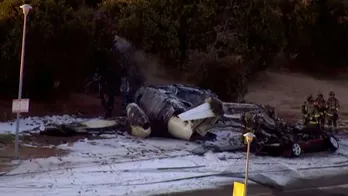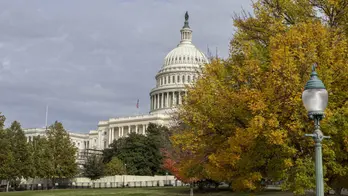In some fights over solar, it's environmentalist vs. environmentalist
Janet McGowan and Steven Roof both live in the town of Amherst, Mass., and they have a lot in common.
They live on the same road, in old houses built amid rolling farmland and maple and birch trees. Both care deeply about the environment and understand that climate change poses a profound threat to people and ecosystems. But they are split over how their community should rein in the emissions making the planet hotter.
Amherst is writing its bylaws for where and how to locate solar projects in the town, and McGowan, a mediator and lawyer who is on the working group to help write those bylaws, has concerns. McGowan says she isn't anti-solar, but like many other residents, she worries about the town's farmland and forests getting converted into solar projects. "To me, it just seems viscerally wrong and counterintuitive," she says. "It just seems really odd to me to cut down a forest to put up a solar facility."
Roof is overcome with a different worry. A professor of earth and environmental science at Hampshire College, he travels with students to the Arctic to study the effects of global warming. He worries that local fears about conserving farms and forests could lead Amherst to enact overly restrictive regulations that limit the town's role in tackling climate change.
"We're at a tipping point," Roof says. "If we don't turn to renewable energy and stop burning fossil fuels, in 10 or 15 years our ecosystems are going to be ravaged from climate change, and there's going to be much greater costs."
McGowan and Roof are like lots of neighbors across the U.S. who are increasingly at odds over where to locate larger solar projects. Sometimes these disagreements are between people who deny climate science and those who accept that human-caused climate change is happening. But these days, the disputes are often between people like McGowan and Roof, who both accept climate science. "It's environmentalist versus environmentalist," McGowan says.
For some people, addressing climate change is paramount, and building large renewable energy projects is worth certain trade-offs because of the greater harms that loom if our grid continues to be dominated by planet-heating fossil fuels. For others, conserving land, habitats or biodiversity is their core value, and they push for larger renewable projects to be built somewhere else.
A new report from the Sabin Center for Climate Change Law at Columbia University identified more than a dozen solar projects that encountered opposition from local conservation groups and environmentalists. Many projects were ultimately delayed, canceled or significantly reduced in size as a result.
The sometimes-difficult choices over solar stem from the fact that society has delayed climate action too long to save everything we want to save, says Michael Gerrard, environmental law professor at Columbia University. While some disagreements between neighbors over what to conserve are inevitable, he says these conflicts can delay renewable energy projects just as climate science demands their urgent adoption.
"There's some very tough trade-offs that have to be involved," Gerrard says. "We are now in the midst of the sixth extinction in geologic time. It's going to get much worse as the climate worsens. If we don't act in a very strong way, we're going to lose far more species. We have to make some sacrifices now in order to avoid far greater losses in the years and decades to come."
Conservationists worry about maintaining the integrity of habitats
Among conservationists in Amherst there isn't a lot of disagreement that the climate emergency is real, says Stephanie Ciccarello, sustainability director for the town. "Everybody seems to be on the same page that yes, climate change is an issue. It's an emergency. We have to do something to address it. But at the same time, how we get to that point, there's some — maybe, I would say — differing opinions," Ciccarello says.
The town of Amherst has a goal of carbon neutrality, or getting planet-heating emissions to zero, by 2050. That will require renewables, including solar, but the question is where. Proposals for large solar, especially near homes, have historically faced opposition in Amherst, Ciccarello says. In 2016, a solar array on top of a landfill got scrapped because it was identified as being a habitat of the endangered grasshopper sparrow. Ultimately, the town built a solar array on a different landfill, but it took seven years.
Today, people in the town still worry about solar disturbing habitats for local animals, and recreation areas, says longtime resident Rob Kusner, professor of mathematics at UMass Amherst who considers himself a conservationist. "One can find oneself in a forest without anyone else around other than moose and deer and the sounds of birds," he says. "The top concern is [solar] interrupts the integrity of the forest."
Amherst already permanently conserves about 30% of its forest, agricultural and open space lands. The town's Energy & Climate Action Committee estimates the amount of land needed for solar on the ground would be comparatively small — about 1%-2% of the town's total land area.
Kusner also fears that solar built in the town's forests could cause erosion and contaminate drinking water supplies. He points to a nearby town, Williamsburg, Mass., where a solar developer paid more than $1 million to settle allegations that it damaged local wetlands and polluted part of a river when constructing a solar project in 2018. That project was built on a former sand and gravel pit.
But most U.S. solar projects in forested areas do not cause erosion and pollution to the water supply, says Jordan Macknick, lead energy-water-land analyst for the National Renewable Energy Laboratory, a research organization primarily funded by the Department of Energy. "Most solar projects that are going to be built are not going to be on those steep hillsides. They're not going to be on former sand and gravel pits, which might be a little bit more vulnerable," Macknick says.
He adds: "We haven't seen this happening even in other projects that we've seen developed near wetlands or on wetlands. Or even projects that have been developed on former forest land."
Debating how trees and solar reduce planet-heating emissions
McGowan also worries about cutting down forests, because trees store carbon. "It's holding carbon in the wood, but also there's a ton of carbon being held in the soil, in the ground, and they're not even sure how much is in the roots," she says.
But when it comes to reducing net greenhouse gas emissions, solar typically reduces more emissions than forests, according to Jonathan Thompson, research director at Harvard Forest, a department of Harvard University.
The town of Amherst recently invited Thompson to a Zoom meeting to talk about the benefits of solar compared to forests, and forests compared to solar. Thompson told the group that forests provide key benefits for biodiversity, water systems and recreation. But to the surprise of some in the meeting, Ciccarello says, the forest ecologist gave strong arguments in favor of solar, strictly from an emissions-reduction perspective. That's because putting solar on the grid can displace fossil fuel plants that often make more emissions than forests can absorb and store.
Conservationists often want rooftop solar. Will that be enough?
Many community members in Amherst who favor conservation say they don't oppose solar. But they want it on residential and commercial rooftops and parking lots, arguing that these spaces have already been taken out of use as fields and forests.
"I would think most people would instinctively think that you'd put it on the built environment first, and then reach for the farms and the forest second or last," McGowan says. "To cut it all down to put up a solar array makes zero sense to me when you can just put it over Target."
But while rooftop solar will be part of the climate solution, it will not be enough to meet clean energy needs going forward, says Jesse Jenkins, professor of engineering at Princeton University who has studied scenarios to reduce emissions. He says for the U.S. to reach its climate goals, the country will need to take lots of land out of commission — at least temporarily — for new solar projects.
That's because the country isn't just going to need renewables to replace fossil fuel power from coal and gas plants. The energy transition is going to mean a lot more new demand for electricity — because of the growing adoption of things like electric vehicles instead of combustion cars, and electric heat pumps instead of gas furnaces, Jenkins says. "What our research shows is that we need to be deploying tens of gigawatts of new solar every year for the next few years, scaling up to hundreds of gigawatts by 2030," he says. "We're not going to get there with rooftops alone."
(A gigawatt is enough electricity to power about 750,000 homes, according to the Energy Information Administration.)
Another obstacle for rooftop solar is cost. Solar power created from rooftops or parking lot canopies is often a lot more expensive than power from the kind of larger solar projects on the ground that towns like Amherst are considering, says Dwayne Breger, director of the Clean Energy Extension at UMass Amherst and, along with McGowan, a member of the group writing the town's solar bylaws. (He's also on the town's Energy & Climate Action Committee, along with Roof.)
According to a recent report from the financial services firm Lazard, installing and operating residential rooftop solar can be about 70% more costly than community and commercial scale solar because of factors like economies of scale and a lower ability to orient the panels toward the sun.
Because solar has a much larger land footprint than fossil fuel plants and because of projections of greater electricity demand, Breger thinks his community needs to realize the energy transition will require more land for solar. "People don't really have a good grasp of how big that is," he says.
"In my mind, quote-unquote 'sacrificing' a small percentage of our open land to solar is a small price to pay for contributing what we — the town, the commonwealth and the nation, the world — need to address climate change."
Engaging conservationists early on can sometimes work
Whether the U.S. reaches its climate goals could come down to places like Amherst, where environmentalists don't always agree on how to deploy renewables. Jason Albritton, program director for North America climate change mitigation at the Nature Conservancy, a conservation nonprofit, says it is possible to have better outcomes for potential land conflicts by engaging conservationists early on, and trying to reduce the overall footprint of renewable projects.
In a recent study, the Nature Conservancy found that one solution for reducing land impacts is "agrivoltaics," or solar projects that are elevated high enough to allow for working farmland or animal grazing underneath the panels. Developers can also plant pollinator-friendly flowers under solar panels to help endangered bee populations.
Albritton says his study calls for more community engagement, especially with conservationists. Without that buy-in, he says, "we just won't reach our climate goals."
In Amherst, the town recently completed a survey to get the community's thoughts and perspectives on solar. About 90% of the over 500 respondents ranked putting solar on parking lot canopies or rooftops as their top choices for solar development. More than a quarter of respondents wrote that conserving forest was one of their top concerns; about a fifth said conserving farmlands was one of their top concerns.
Breger takes some comfort in the fact that last year the town council considered a moratorium on all solar development, but voted against it. Instead, Amherst decided to make new solar bylaws and a map outlining where solar can go. Breger and McGowan say they hope to have the drafts of the bylaws done by the end of the summer.
Breger hopes the town will not write severely restrictive regulations like some neighboring communities. "We want to be careful with our solar development," he says, "but not be over restrictive. We want to address our climate emergency."
Disclaimer: The copyright of this article belongs to the original author. Reposting this article is solely for the purpose of information dissemination and does not constitute any investment advice. If there is any infringement, please contact us immediately. We will make corrections or deletions as necessary. Thank you.







